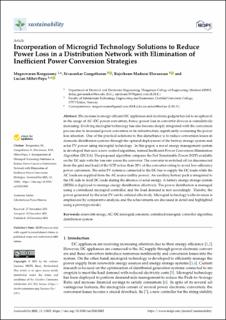| dc.contributor.author | Rengasamy, Mageswaran | |
| dc.contributor.author | Gangatharan, Sivasankar | |
| dc.contributor.author | Elavarasan, Rajvikram Madurai | |
| dc.contributor.author | Mihet-Popa, Lucian | |
| dc.date.accessioned | 2022-01-25T13:38:28Z | |
| dc.date.available | 2022-01-25T13:38:28Z | |
| dc.date.created | 2021-12-13T12:02:44Z | |
| dc.date.issued | 2021 | |
| dc.identifier.citation | Sustainability. 2021, 13 (24), Artikkel 13882. | en_US |
| dc.identifier.issn | 2071-1050 | |
| dc.identifier.uri | https://hdl.handle.net/11250/2839257 | |
| dc.description.abstract | The increase in energy-efficient DC appliances and electronic gadgets has led to an upheaval in the usage of AC–DC power convertors; hence, power loss in converter devices is cumulatively increasing. Evolving microgrid technology has also become deeply integrated with the conversion process due to increased power converters in its infrastructure, significantly worsening the power loss situation. One of the practical solutions to this disturbance is to reduce conversion losses in domestic distribution systems through the optimal deployment of the battery storage system and solar PV power using microgrid technology. In this paper, a novel energy management system is developed that uses a new control algorithm, termed Inefficient Power Conversion Elimination Algorithm (IPCEA). The proposed algorithm compares the Net Transferable Power (NTP) available on the DC side with the loss rate across the converter. The converter is switched off (or disconnected from the grid and load) if the NTP is less than 20% of the converter rating to avoid low-efficiency power conversion. The solar PV system is connected to the DC bus to supply the DC loads while the AC loads are supplied from the AC source (utility power). An auxiliary battery pack is integrated to the DC side to feed DC loads during the absence of solar energy. A battery energy storage system (BESS) is deployed to manage energy distribution effectively. The power distribution is managed using a centralized microgrid controller, and the load demand is met accordingly. Thereby, the power generated by the solar PV can be utilized effectively. Microgrid technology’s effectiveness is emphasized by comparative analysis, and the achievements are discussed in detail and highlighted using a prototype model. | en_US |
| dc.language.iso | eng | en_US |
| dc.publisher | MDPI | en_US |
| dc.rights | Navngivelse 4.0 Internasjonal | * |
| dc.rights.uri | http://creativecommons.org/licenses/by/4.0/deed.no | * |
| dc.subject | AC/DC microgrid | en_US |
| dc.subject | automatic centralized microgrid | en_US |
| dc.subject | controller algorithm | en_US |
| dc.subject | distribution system | en_US |
| dc.subject | renewable energy | en_US |
| dc.title | Incorporation of Microgrid Technology Solutions to Reduce Power Loss in a Distribution Network with Elimination of Inefficient Power Conversion Strategies | en_US |
| dc.type | Peer reviewed | en_US |
| dc.type | Journal article | en_US |
| dc.description.version | publishedVersion | en_US |
| dc.rights.holder | © 2021 by the authors. Licensee MDPI, Basel, Switzerland. | en_US |
| dc.subject.nsi | VDP::Teknologi: 500::Elektrotekniske fag: 540::Elkraft: 542 | en_US |
| dc.source.volume | 13 | en_US |
| dc.source.journal | Sustainability | en_US |
| dc.source.issue | 24 | en_US |
| dc.identifier.doi | 10.3390/su132413882 | |
| dc.identifier.cristin | 1967701 | |
| dc.source.articlenumber | 13882 | en_US |
| cristin.ispublished | false | |
| cristin.fulltext | original | |
| cristin.qualitycode | 1 | |

